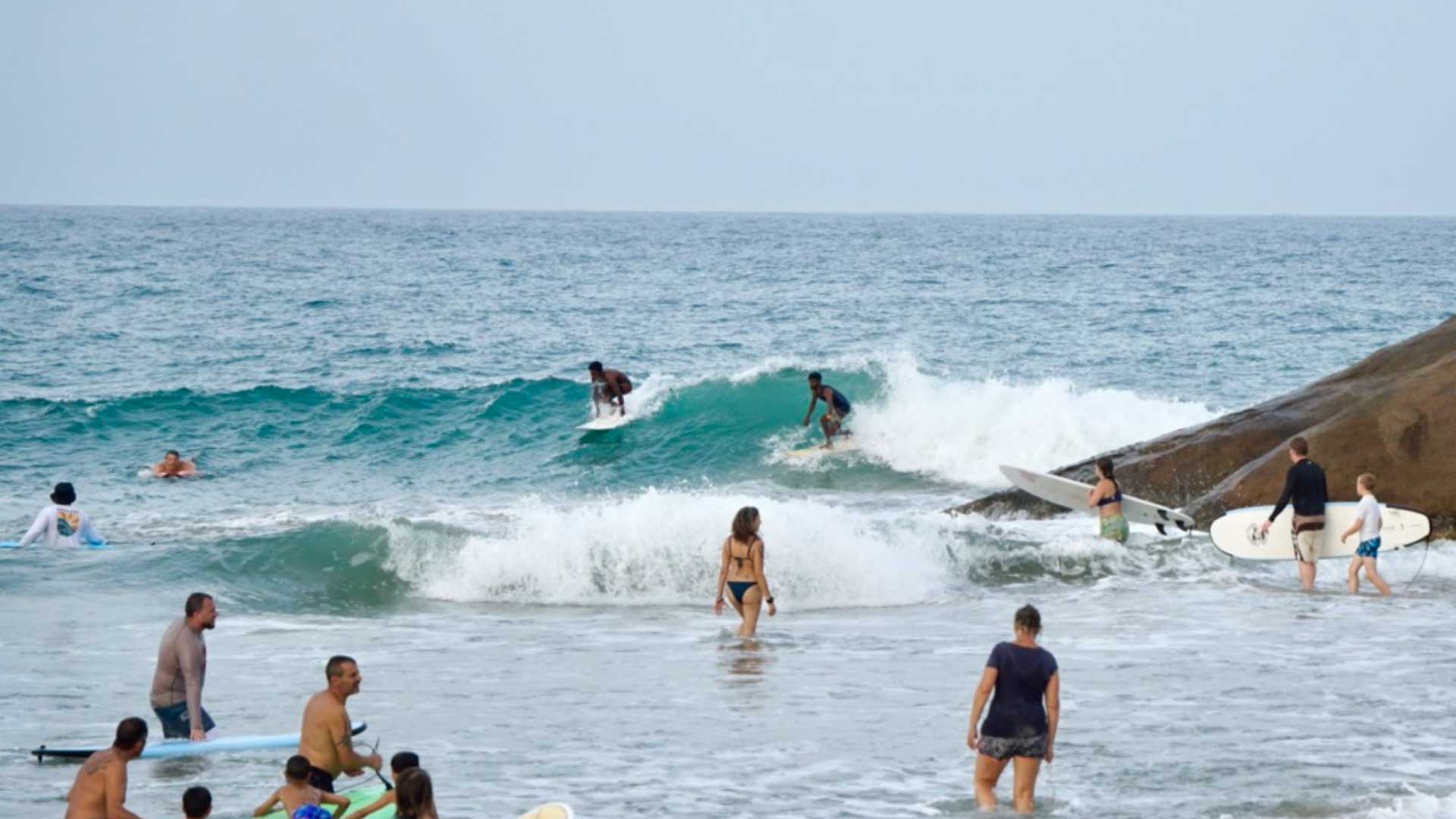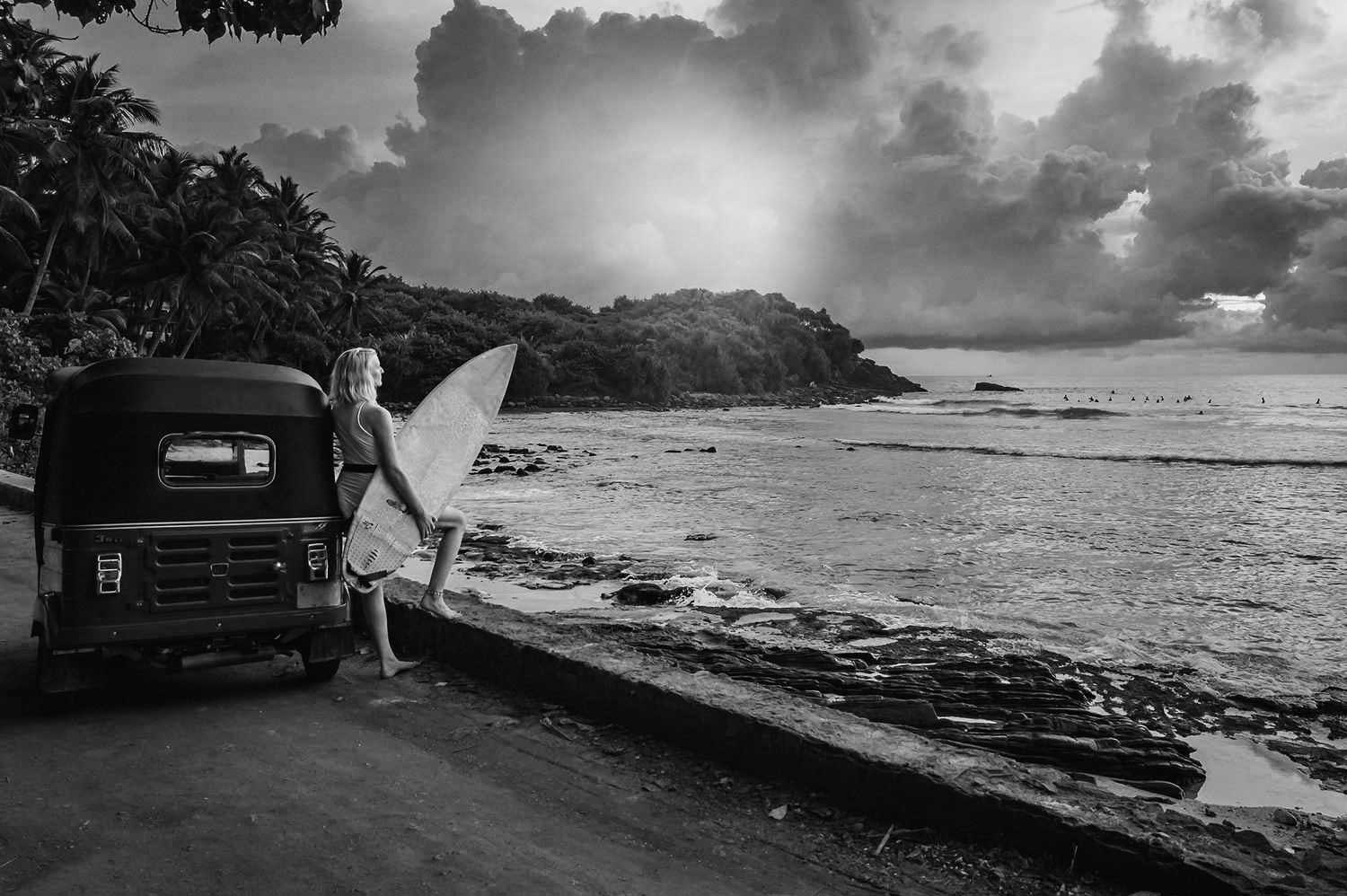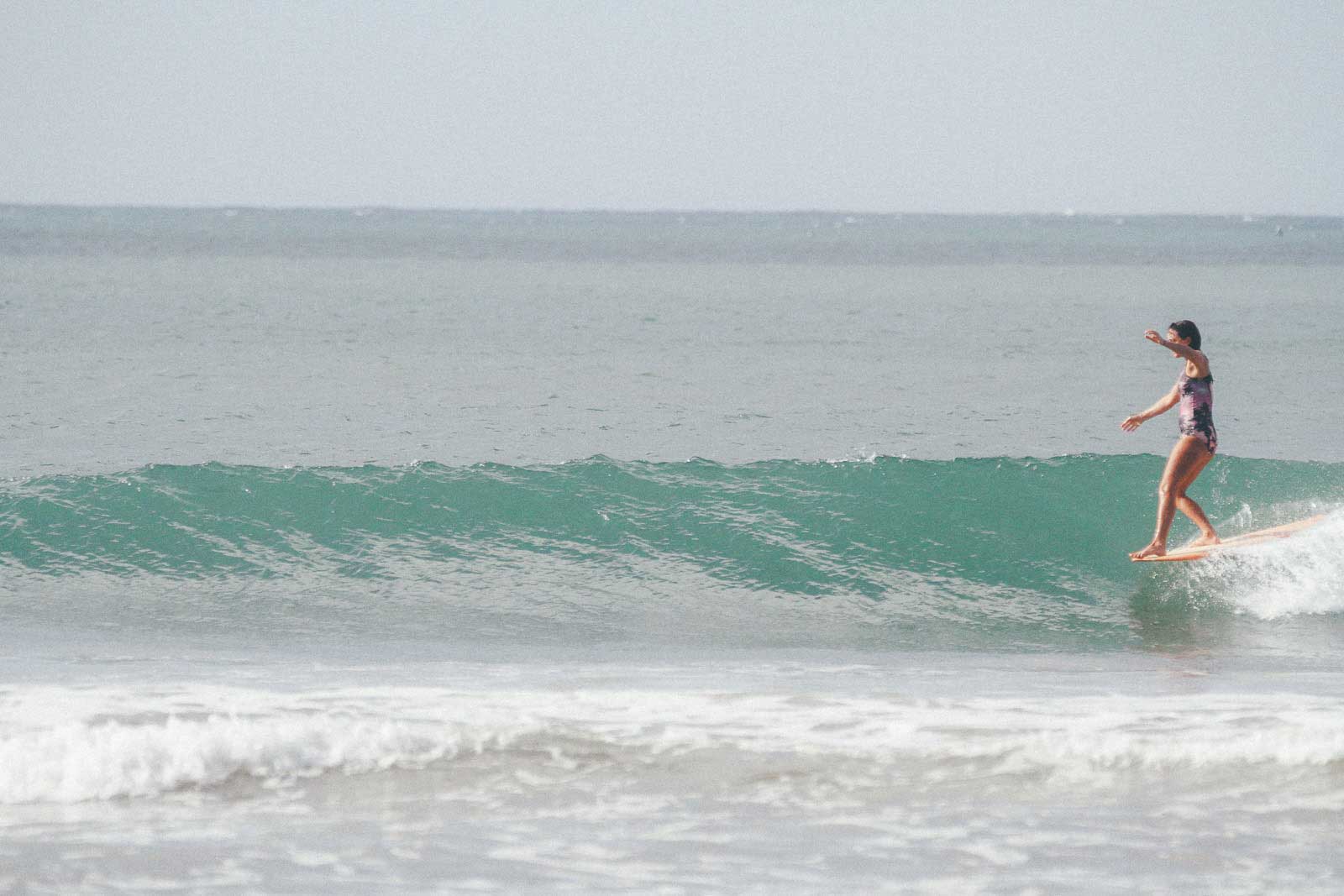SURFING SRI LANKA:
THE SURF & TRAVEL Guide
Surfing in Sri Lanka has exploded in popularity, transforming this teardrop-shaped island into one of Asia’s premier wave-riding destinations. With its spectacular coastlines and perfect Sri Lankan waves suitable for every skill level, it’s particularly appealing for beginners and intermediate surfers looking to progress their skills in tropical conditions.
Why Sri Lanka Is a Surfer’s Paradise
What makes surfing in Sri Lanka special is its dual surfing seasons across two distinct coastlines. The southwest coast operates from November to April, while the eastern shore (primarily Arugam Bay) works from April through October. This unique setup ensures year-round surfing possibilities regardless of when you visit.
The Sri Lankan waves are notably more approachable than those found in Indonesia, characterized by their softer, fatter profile. This friendly nature stems from two factors: first, southern swells must travel further to reach the island, and second, the natural formation of Sri Lanka’s reefs and bays effectively tempers larger wave sets.
The diversity of breaks is impressive. You’ll discover everything from shallow reefs with high walls and barrel potential near Ram’s and Mirissa to gentler A-frame formations like those in Midigama. Beach breaks in Sri Lanka are abundant too, including the emerging spots at SK Town and the beginner-friendly waves at Hiriketiya.
Perhaps equally appealing is the welcoming atmosphere in the lineup. Localism is practically nonexistent at most breaks, with surfers typically greeting newcomers warmly and offering helpful advice about navigating the reefs. Add to this the affordability factor—meals for under $3 and quality accommodations starting around $80 nightly—and you’ve got an irresistible destination.
Best Surf Spots in Sri Lanka: Southwest Coast
Hikkaduwa: The Classic Sri Lankan Surf Spot
Possibly the most frequented spot on the southwest coast, Hikkaduwa offers variety for all levels. Beginners gravitate toward the sand-bottom main beach where surf schools operate, while experienced surfers head to Benny’s, an adrenaline-pumping reef break with steep, fast lefts. Surfing in Hikkaduwa remains popular year after year for good reason – consistent waves and excellent infrastructure make it a reliable choice.
Weligama: Perfect for Learning to Surf in Sri Lanka
This represents the pinnacle of beginner-friendly surfing in Sri Lanka. Protected by two elongated headlands, Weligama Bay receives softer, slower beach breaks even when larger swells pound nearby reefs. The entire bay features sand-bottom conditions, with numerous highly-rated surf camps in Sri Lanka lining the coastal road behind the beach. If you’re new to surfing, this is where you want to start your Sri Lankan surf journey.
Midigama: Sri Lanka’s Reef Break Paradise
When December offshore winds sweep through Midigama, the waves deliver exceptionally enjoyable rides. Notable breaks include Coconuts, a fast, hollow left-hander, and Ram’s, famous for its high barrels that crash just offshore from several prime surf accommodations. Intermediate surfers seeking to progress will find Midigama offers the perfect challenge.
Ahangama: Sri Lanka’s Surf Camp Hub
Following Midigama along the Matara Road, Ahangama continues the reef theme with popular spots like Sticks and Marshmallow. The area stretches considerably along the coastline, allowing room for beach breaks such as the up-and-coming Kabalana spot. This region hosts some of Sri Lanka’s finest surf camps and has become increasingly popular with digital nomads who surf.
Kabalana Beach: The Rising Star
This stunning beach has become one of the hottest new destinations for surfing in Sri Lanka. Home to possibly the best A-frame reef break on the island—The Rock—Kabalana’s popularity stems from its versatility. It offers an easy beach break for beginners, excellent dining options, proximity to Ahangama and Midigama breaks, and premium beachfront accommodations.
Hiriketiya: The Hip Surf Enclave
Once a hidden gem, Hiriketiya has transformed rapidly in recent years. What was once a collection of beach shacks has evolved into a trendy destination with hipster coffee shops and luxury hotels. Despite this development, it remains excellent for learning to surf in Sri Lanka, thanks to its beginner-friendly beach break. Advanced surfers appreciate the left-hand point break offering long, rapid rides over shallow reef.
SK Town: The Hidden Gem
This somewhat hidden beach break between Dickwella and Mirissa delivers impressive peaks along its entire length. On powerful days, neat wedges form that break both left and right, though extremely powerful conditions can create closeouts. SK Town remains one of the less crowded spots for surfing in Sri Lanka.
Sri Lanka’s East Coast Surfing: Arugam Bay
When discussing surfing in Sri Lanka, Arugam Bay stands as the undisputed jewel of the east coast. This surfing mecca shines during summer months from June through October when the southwest coast experiences monsoon conditions.
The bay offers diverse wave options, from the barrel potential of fast-breaking Elephant Rock to the sand-bottomed Baby Point, perfect for novices. Beyond surfing, the town delivers vibrant nightlife and a relaxed atmosphere that keeps surfers returning year after year.
Main Point at Arugam Bay is considered one of the best right-hand point breaks in Asia, drawing surfers from around the world during the peak season. When conditions align perfectly, you can enjoy rides of up to 400 meters on this world-class wave.
Best Time for Surfing in Sri Lanka
The island’s surf season divides cleanly into two parts based on distinct monsoon patterns:
Southwest Monsoon (May-September)
During this period, Arugam Bay becomes the clear choice as rains sweep across the south coast and storm winds chop up swells on the southwest. June and July represent peak months for surfing in Sri Lanka’s east coast, when even the sand-cushioned beginner wave at the main beach hits its stride.
Northeast Monsoon (October-April)
As conditions dry out along the stunning southwest beaches, offshore winds become more frequent and swells organize into tidy sets for the reefs. This season offers the greatest variety of functioning surf spots in Sri Lanka, from Hiriketiya to Hikkaduwa. As the season progresses, conditions typically mellow further, with January through March often featuring lighter conditions than pre-Christmas.
Surf Difficulty: Why Sri Lanka Is Perfect for Progression
Sri Lanka truly excels at catering to the easier end of the surfing spectrum. Beginners will discover super-soft waves at locations like Hiriketiya and Ahangama, making it an ideal destination for those learning to surf.
This accessibility largely results from the fringing reefs that moderate the strong southwest swells during peak season. Arugam Bay represents an exception, generally better suited for intermediates, though it still offers point breaks appropriate for complete beginners and features numerous surf schools.
Another advantage is Sri Lanka’s ability to help surfers transition from beach breaks to reefs. Unlike the shallow, urchin-filled reefs found elsewhere, many Sri Lankan reefs feature relatively deep water—Marshmallow in Ahangama and Coconuts in Midigama are prime examples. This makes them ideal for acclimatizing to surfing over hard coral and rock if you’re new to reef breaks.
Video surfing in Sri Lanka
Surf Camps and Accommodations in Sri Lanka
If you want to maximize your surfing time in Sri Lanka with included instruction and avoid planning logistics yourself, the island offers exceptional surf camps. The quality has risen significantly in recent years, with qualified instructors tailoring lessons and spot selection to all skill levels, and accommodations that rival the island’s finest hotels.
Top Surf Camps in Sri Lanka
- Weligama hosts numerous beginner-friendly camps with excellent instructors
- Ahangama features more intermediate-focused camps with access to quality reef breaks
- Hiriketiya has boutique surf camps combining yoga and surfing in a hip environment
- Arugam Bay offers seasonal camps that operate during the east coast season
For those preferring more independence, Sri Lanka excels at oceanfront hotels. Some of the world’s most luxurious surf-focused accommodations can be found here at surprisingly reasonable prices. Often, a sea-view room within walking distance to breaks costs around $80 per night, complete with infinity pool and breakfast.
Sri Lanka Surf Accommodation Tips
- Book in advance during peak season (December-January for southwest, June-July for east)
- Look for accommodations with on-site board rental or storage
- Consider places with sunset views – the evening light over the Indian Ocean is spectacular
- Many hotels offer airport transfers specifically designed for surfers with board bags
Beyond Surfing: Sri Lanka’s Other Attractions
Sri Lanka delivers experiences far beyond its warm waves and reef breaks. The island features fascinating Buddhist culture, delectable cuisine, and an abundance of temples, shrines, and pristine beaches that make for perfect rest days between surf sessions.
Safari Adventures
Many prime surf destinations in Sri Lanka on the southwest coast provide convenient access to major safari areas. Unlike what you might expect, Sri Lanka offers safari experiences reminiscent of the Serengeti, with vast plains inhabited by elephants and leopards. Yala National Park is among the most popular, offering the highest leopard density in the world, while Udawalawe National Park is renowned for its elephant populations.
Sigiriya Rock
Often called the Eighth Wonder of the World, this breathtaking palace atop a stone bluff dates back to the 5th century. History enthusiasts and culture lovers can climb the impressive rock palace, view ancient Buddhist shrines, and enjoy sweeping vistas across Sri Lanka’s central plains. Many surfers combine a surf holiday in Sri Lanka with cultural excursions to sites like Sigiriya.
Ella Highlands
Prepare your leg muscles for surfing with a visit to the misty highland town of Ella. Surrounded by tea fields and dramatic peaks, it offers spectacular views and excellent hiking opportunities. Popular treks include Ella Rock and Little Adam’s Peak, followed by relaxing visits to tea factories. The famous train journey from Kandy to Ella is considered one of the most beautiful rail trips in the world.
Practical Guide for Surfing in Sri Lanka
Location and Getting to Sri Lanka
Sri Lanka sits just 883 miles from India, resembling a teardrop falling from the subcontinent (hence its nickname). Colombo’s Bandaranaike International Airport serves as the main international gateway, with long-haul connections from Europe, the Middle East, and beyond. Qatar Airways often proves ideal for surfers, as their indirect connections serve multiple airports and include surfboard carriage in standard baggage allowances.
Local Transportation for Surfers
For those traveling without boards, local buses offer an economical and culturally immersive way to navigate the island. Surfers carrying equipment might prefer private taxi transfers, which can be arranged through groups like Sri Lanka Taxi Share. For shorter journeys between south coast surf spots, tuk-tuks provide the most affordable and convenient option, though board security during transport might require some improvisation.
Essential Surf Gear for Sri Lanka
- Sunscreen is absolutely crucial – the tropical sun is intense
- Rash guards are recommended for protection from both sun and potential reef encounters
- A tropical wax works best for the warm water temperatures
- Reef booties are optional but helpful at some locations with sharper reefs
- First aid kit with items to treat minor cuts and reef rash
Budget Considerations
- Surfboard rental typically costs $5-10 USD per day
- Surf lessons range from $25-40 USD for a 2-hour session
- Accommodation varies from $10 for basic rooms to $100+ for luxury options
- Meals are very affordable, with local rice and curry dishes around $3-5
- Tuk-tuk rides between nearby surf spots cost approximately $3-5 each way
Final Thoughts on Surfing in Sri Lanka
Whether you’re catching your first wave or seeking the perfect barrel, Sri Lanka’s warm waters, friendly locals, and diverse breaks create an irresistible surfing paradise that deserves a prominent place on every wave rider’s bucket list. The combination of year-round waves, affordable prices, and stunning natural beauty make it one of the world’s most appealing surf destinations.
What sets surfing in Sri Lanka apart from other tropical destinations is the perfect balance of quality waves without overwhelming crowds or aggressive localism. It offers that increasingly rare combination: world-class surf experiences in an environment that still feels authentic and welcoming.
For beginners, there’s perhaps no better place to learn, while intermediate and advanced surfers will find plenty of challenging waves to push their progression. When you factor in the rich cultural experiences, delicious cuisine, and unforgettable landscapes, it’s easy to see why Sri Lanka has become a premier surf destination that surfers return to year after year.
Surfing Sri Lanka
Surfing Sri Lanka-
Crowds7/10 Good
-
Consistency6/10 Normal
-
Ease of getting there7/10 Good
-
Ease of getting around5/10 Neutral
-
For beginners8/10 Very good
-
For intermediate7/10 Good
-
For experts4/10 Passably
Pro's
- Fun waves
- Culture trip
- Tasty food
The Bad
- Crowds
- Lack of world-class waves
Views: 159












